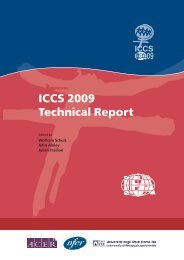Teacher Education and Development Study in Mathematics - IEA
Teacher Education and Development Study in Mathematics - IEA
Teacher Education and Development Study in Mathematics - IEA
You also want an ePaper? Increase the reach of your titles
YUMPU automatically turns print PDFs into web optimized ePapers that Google loves.
58<br />
TEACHER PAY AND STUDENT MATHEMATICS ACHIEVEMENT<br />
Botswana 8<br />
Composition of the teacher labor force<br />
In the early 2000s, Botswana had almost 13,000 primary school teachers (Figure 6) for<br />
about 330,000 primary school students, or a student–teacher ratio of 26:1. The number<br />
of primary teachers <strong>and</strong> the number of primary students barely changed from 1998<br />
on. Primary teach<strong>in</strong>g is largely a female profession; approximately 80% of the teach<strong>in</strong>g<br />
workforce is female. Close to 95% of teachers are Batswana, but the proportion of non-<br />
Batswana has risen slowly, from four percent <strong>in</strong> 1995 to six percent <strong>in</strong> 2004. Although<br />
the proportion of “untra<strong>in</strong>ed” primary school teachers <strong>in</strong> Botswana fluctuates from<br />
year to year, the percentage <strong>in</strong> the early 2000s hovered around 10%.<br />
The number of secondary school teachers doubled <strong>in</strong> the 10 years follow<strong>in</strong>g 1995<br />
(Figure 6). The number of secondary school students <strong>in</strong>creased by 50% <strong>in</strong> the same<br />
period, from 103,000 to almost 159,000. Thus, the student–teacher ratio decl<strong>in</strong>ed<br />
substantially <strong>in</strong> secondary education, from more than 20:1 to 15:1. Another major<br />
change that occurred <strong>in</strong> the 10 years follow<strong>in</strong>g 1995 was the proportion of teachers<br />
identify<strong>in</strong>g as Batswana or non-Batswana: <strong>in</strong> 1995, more than 30% of secondary school<br />
were non-Batswana; by 2004, the proportion had dropped to 14%, suggest<strong>in</strong>g that the<br />
ma<strong>in</strong> expansion of secondary education occurs <strong>in</strong> government <strong>and</strong> government-aided<br />
schools where the teach<strong>in</strong>g force is primarily Batswana. Most of the expansion took<br />
place <strong>in</strong> grant-aided schools rather than <strong>in</strong> schools run directly by the government.<br />
Untra<strong>in</strong>ed teachers decl<strong>in</strong>ed as a percentage of all secondary school teachers, from 15%<br />
<strong>in</strong> 1995 to 6% <strong>in</strong> 2004.<br />
Figure 6: Botswana, Number of Primary <strong>and</strong> Secondary <strong>Teacher</strong>s, 1995 to 2004<br />
14,000<br />
12,000<br />
Number of <strong>Teacher</strong>s<br />
10,000<br />
8,000<br />
6,000<br />
4,000<br />
2,000<br />
0<br />
1995<br />
1996 1997 1998<br />
Primary Total<br />
1999 2000 2001 2002 2003 2004<br />
Year<br />
Secondary Total<br />
Source: Central Statistics Bureau, Botswana.<br />
8 Unless otherwise specified, data for Botswana were drawn from these websites:<br />
http://www.moe.gov.bw/tsm/about/structure.html;<br />
http://www.ei-ie.org/en/news/show.php?id=5&theme=rights&country=botswana;<br />
http://www.moe.gov.bw/<strong>in</strong>formation/<strong>in</strong>dex.html.

















